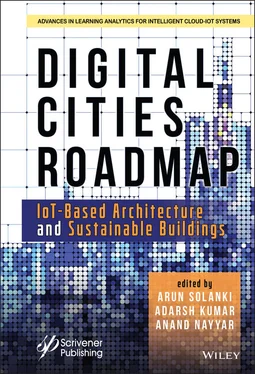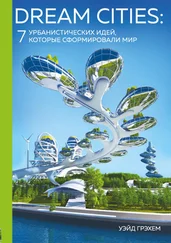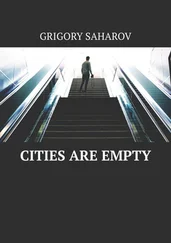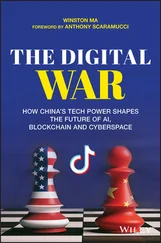Chapter 6, “Revolutionizing Geriatric Design in Developing Countries: IoT-Enabled Smart Home Design for the Elderly,” presents a study that emanated from concern for the growing population of the elderly in our cities who are forced to live alone without much assistance due to shrinking family size and intercity and international migration of their children in search of better job opportunities. The study looks at the middle-class to upper-middle-class elderly population aged 65 and above living in urban cities of India such as Bangalore. This group usually comes from a well-educated background with mid-level financial security. Chapter 7, “Sustainable E-Infrastructure for Blockchain-Based Voting System,” explores the block-chain technology used to implement an electronic voting system. E-voting can change the way in which we have voted for decades. The main feature of this system is that voters can cast their vote from anywhere in the world. As this voting process starts going digital and online, voters from outside the country can also vote from wherever they are, which can increase the total voting percentages tremendously. Chapter 8, “Impact of IoT Enabled for Smart Cities: A Systematic Review and Challenges,” discusses the way in which the IoT has influenced specific areas of our daily lives. Moreover, the reader will discover the fundamental options that come with smart cities and exactly why a contemporary community is given that name, along with some of its problems and solutions. Additionally, this particular chapter covers the role of 5G technologies in the IoT along with big data analysis. Finally, it includes the primary options that come with the Indian perspective of smart cities by 2030 to enhance the daily lives of humans, along with conceptual and block diagrams.
Chapter 9, “Indoor Air Quality (IAQ) in Green Buildings: A Prerequisite to Human Health and Well-Being,” examines why the IAQ inside buildings is one of the most important determining factors of human health as more than half of the air inhaled by a person during his/her lifetime is at home. Illnesses associated with environmental exposure often stem from indoor air exposure. Prominent air pollutants are found indoors, including volatile organic compounds (VOCs), particulate matter (PM), carbon monoxide (CO), lead (Pb), nitrogen oxides (NOx), and asbestos. Smart and sustainable approaches to green building construction should incorporate IAQ as a critical component of building design as the air quality is directly related to the inhabitants’ sound well-being. Chapter 10, “An Era of Internet of Things Leads to Smart Cities Initiatives towards Urbanization,” outlines the components of smart cities and IoT technologies used in smart cities for establishing relationships between industries and their services, and includes a table showing various sectors providing different services and related principal issues of IoT technologies. Finally, the challenges of smart cities, urbanization, and IoT are highlighted. The perceived concept of the smart city appears to initiate the new standards for urban city planning. Urban planners imagine the city of the future as smart and economical. This initiative will always remain critical for development and sustainability. Chapter 11, “Trip-I-Plan: A Mobile Application for Task Scheduling in Smart City’s Sustainable Infrastructure,” provides comprehensive, automatic task rescheduling for mobile application. This approach will enhance the growth of smart city workers’ planning and boost the growth of smart sustainable infrastructure. Here, a comparative study of existing mobile applications of task scheduling is also presented.
Chapter 12, “Smart Health Monitoring for Elder Care in Indoor Environments,” discusses the various technologies that are being used by researchers to measure indoor environmental quality, human health and well-being along with case studies and real-life examples. Technology plays a crucial role in supporting the self-sufficient living of the elderly and their caregivers. However, the environmental quality of the spaces they reside in affects their health. Real-world case studies and their results are discussed in subsequent sections. Finally, available tools and research to aid readers delve further into this vital application area are discussed. Chapter 13, “A Comprehensive Study of IoT Security Risks in Building a Secure Smart City,” presents a holistic review of ML/DL algorithms that can be deployed to improve security. The IoT is capable of assimilating a variety of heterogeneous end systems by facilitating seamless access and communication among an expansive range of devices, people and their environment, making it the key feature in developing the idea of smart cities. This chapter delineates the challenges related to the technology’s implementation and standardization. It briefly overviews existing IoT architectures and enabling technologies, and also explores the prospects of ML/DL methodologies that can be implemented on the IoT platform to maintain an admissible level of services, security and privacy issues, with the aim of enhancing the overall experience of smart cities.
Chapter 14, “Role of Smart Buildings in Smart City: Components, Technologies, Indicators, Challenges, and Future Research Opportunities,” presents various indicators, technologies, components, and features of smart buildings in any smart city. General architectures are subsequently discussed along with the various supporting technologies and requirements of smart buildings for smart cities. The chapter ends with a discussion of the different challenges followed by future research opportunities in the domain of smart buildings in a smart city. Chapter 15, “Effects of Green Buildings on the Environment,” discusses concerns related to rapidly increasing environmental and sustainability issues like urbanization, climate change, loss of biodiversity and degradation of resources, which highlight the need for advancements in housing. Green building is the theory, science and styling of buildings planned and constructed in accordance with a minimum impact on the surroundings by reducing utilization of water, energy, and disturbances in the surrounding environment in which the building is located. This contribution is an attempt to appraise the value of green buildings compared to standard buildings. An attempt is also made to illustrate the available good practices regarding green structures in India.
The information provided in this book will be an incentive to the researchers, academicians and industry professionals interested in IoT-based architecture and sustainable buildings. The book also provides a platform to exchange knowledge in the field of energy efficiency and various tools and methods used to develop green technologies for construction in smart cities.
We would like to express our sincere gratitude to the contributors to the book, who supported us with the contribution of their valuable work and dedication to make this book a resounding success. Last but not the least, we thank Scrivener Publishing and associated production editors for handling the project and making this book a reality.
The Editors
January 2021
1
The Use of Machine Learning for Sustainable and Resilient Buildings
Kuldeep Singh Kaswan 1 * and Jagjit Singh Dhatterwal 2
1 School of Computing Science and Engineering, Galgotias University, Greater Noida, India
2 Department of Computer Science & Applications, PDM University, Bahadurgarh, India
Abstract
The use of Artificial Intelligence to ensure that intelligent and resilient buildings are sustainably developed. The intelligence displayed in buildings by electronic devices and software operated systems is artificial intelligence which perceives the building environment and takes actions aimed at optimizing output in a given context or constraint. A complex, sensitive infrastructure that ensures efficient, cost-effective and environmentally acceptable conditions for every occupant by constantly communicating with its four basic elements: locations (components, frameworks, facilities); processes (automation, control systems), staff (services, users) and management (maintaining, performance) and processes (controlling, systems); and they separate current technologies into two major groups, occupantcentered and energy-centered facilities. The first level approaches that use ML for occupant dimensions, including (1) occupancy and identity estimations, (2) behavior recognition and (3) choice and enforcement estimates. The approach in the second-class category used ML to approximate energy or device-related aspects. It is divided into three categories, (1) estimating the energy profiling and demand, (2) profiling and detection of faults of devices, and (3) sensor inferiority. In this chapter, we focus on guided study, unrestricted learning and improving learning. The main variants, implications of specific parameter choices are explored and we generate standard algorithms. Finally, discuss some of the challenges and opportunities in the built environment to apply machine learning.
Читать дальше

![Чарльз Диккенс - A Tale of Two Cities [С англо-русским словарем]](/books/26616/charlz-dikkens-a-tale-of-two-cities-s-anglo-thumb.webp)










